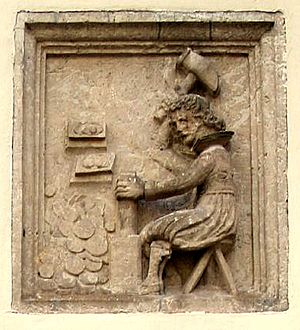Hammered coinage facts for kids
Hammered coinage refers to coins made by hand, using a hammer. This was the main way coins were made from when they were first invented, thousands of years ago, until about the 1500s or 1600s. It's different from cast coinage, which uses molds, and milled coinage, which uses machines.
Contents
How Hammered Coins Were Made
Hammered coins were created by placing a blank piece of metal, called a planchet, between two special metal stamps called dies. One die, called the pile or anvil die, was usually set firmly into a sturdy surface, like a log. The other die, called the trussel, was held by a person.
A worker would place the blank metal piece on the bottom die. Then, they would hold the top die over it. Finally, they would strike the top die with a heavy hammer. This powerful hit would press the images onto both sides of the metal, turning it into a coin.

Making coins this way meant that each coin was a little different. It was hard to make them all perfectly round or the exact same size. Because of this, some dishonest people would try to cheat. They might "clip" coins by cutting off small pieces of the precious metal from the edges. It was hard to tell if a coin had been clipped because they weren't perfectly round to begin with.
Another trick was "sweating" coins. This involved putting silver coins in a bag and shaking it hard. Tiny bits of silver dust would rub off the coins. This dust could then be collected and sold.
When Machines Took Over
Over time, new ways of making coins appeared. Machines started to make coins, creating what are called milled coins. These machine-made coins were much more uniform and harder to clip or sweat.
Slowly, hammered coins became less common. France was one of the first countries to switch completely to machine-made coins in 1643. In England, hammered coins were still made until 1662, even though some machine-made coins had been tried out earlier. Some places, like Venice, kept making hammered coins until the 1770s.
Coins Made by Casting
Another old way to make coins was by casting them. This method was very popular in Asia, especially in China. Instead of hammering, molten metal was poured into molds.
Sometimes, a single mold could make many coins at once, like branches on a tree. These coins often had a square hole in the middle and were called cash. Once the metal cooled, the individual coins would be broken off from the main metal piece. This casting method continued in China until the 1800s.
Hammered Coin Production
See also
 In Spanish: Macuquina para niños
In Spanish: Macuquina para niños
- Milled coinage





